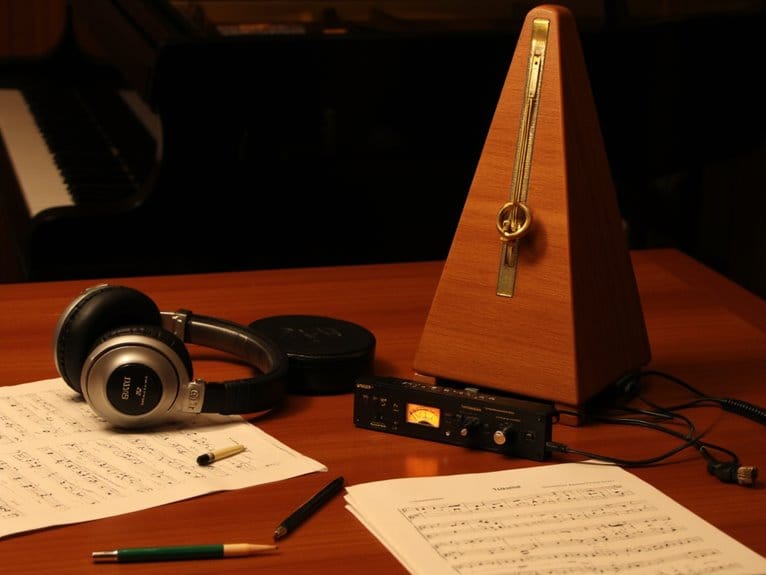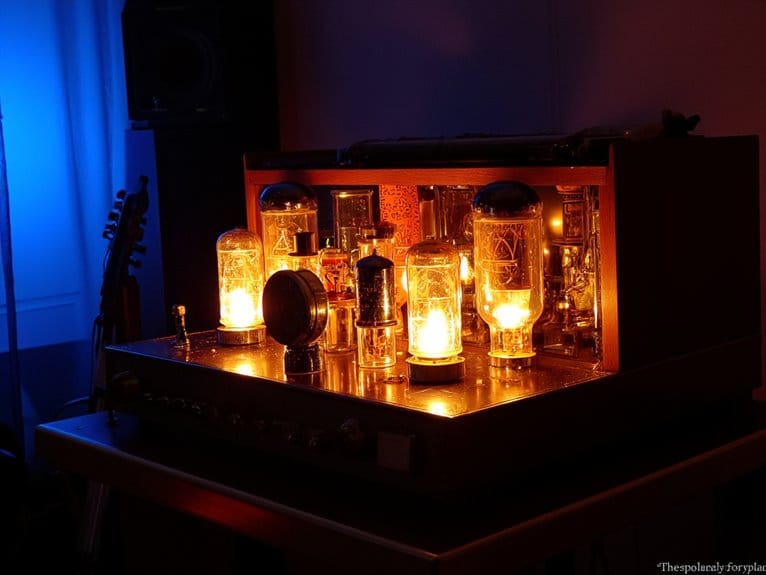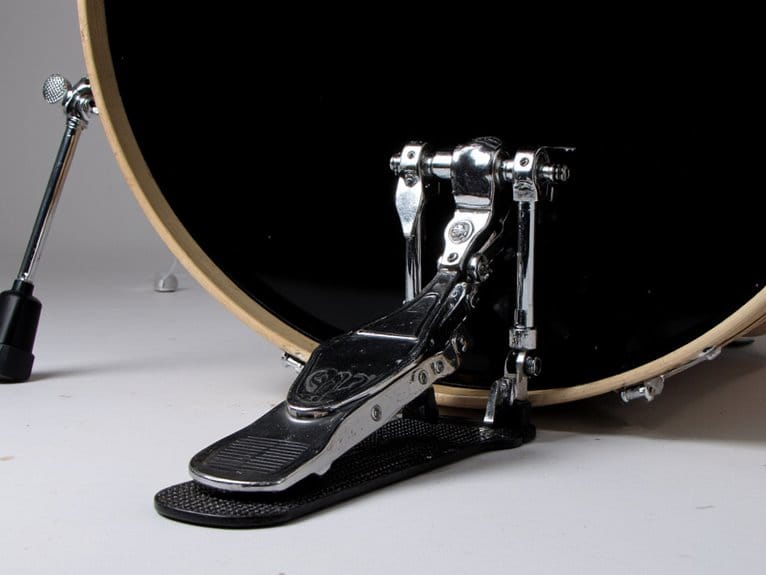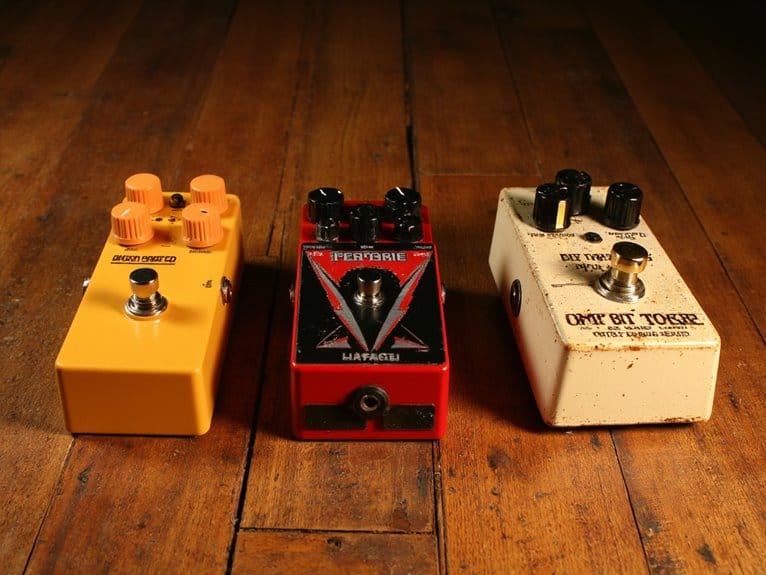Metronome and Click Track Practice Strategies
Start your metronome practice at 90 BPM using a multisensory approach that combines counting aloud, clapping, and foot movement to build genuine rhythmic independence. Record your sessions to identify timing inconsistencies that you can’t hear while playing, then use visual metronome apps or DAWs to pinpoint exactly where you’re rushing or dragging. Practice rhythmic subdivisions like triplets, increase tempo by 5 BPM increments, and focus on problematic passages separately. These foundational techniques reveal advanced timing strategies that transform mechanical practice into musical mastery.
We are supported by our audience. When you purchase through links on our site, we may earn an affiliate commission, at no extra cost for you. Learn more.
Notable Insights
- Start metronome practice at medium tempo (90 BPM) using scales, then build speed incrementally by 5-10 BPM weekly.
- Record practice sessions with click tracks to objectively identify timing inconsistencies and tempo deviations during playback analysis.
- Use multisensory approaches including counting aloud, clapping, and foot movement to develop a reliable internal clock.
- Isolate problematic passages and practice them as separate segments with continuous looping at controlled speeds.
- Track progress systematically by documenting tempo settings, accuracy percentages, and error patterns with audio timestamps.
Building Your Internal Clock and Rhythmic Independence
While most musicians can keep basic time when they’re focused, developing a truly reliable internal clock requires deliberate practice that goes far beyond simply playing along with a metronome.
You’ll need to engage multiple cognitive pathways simultaneously, which means counting rhythms out loud while playing, clapping, and maintaining steady foot movement. This multisensory approach activates language-processing areas in your brain, reinforcing timing accuracy through conscious understanding rather than just motor memory.
Recording yourself regularly provides objective feedback that reveals subtle timing inconsistencies you can’t hear while performing. When recording your practice sessions, ensure your microphone maintains a signal-to-noise ratio above 80 dB for clear playback analysis of your timing precision. Begin your metronome work with medium tempo practice using scales or arpeggios at around 90 beats per minute to establish a solid foundation.
Practice rhythmic subdivisions like triplets, deliberately placing notes ahead of, on, and behind the beat to develop your internal groove and rhythmic flexibility, transforming rigid pulse into an elastic, expressive musical tool. Use a DAW to track your metronome sessions, which allows for repetitive playback and detailed analysis of your timing tendencies.
Spotting and Fixing Tempo Problems in Your Playing
Once you’ve strengthened your internal clock through deliberate practice, you’ll inevitably discover that tempo problems don’t just disappear—they hide in plain sight, masked by your own subjective perception while you’re playing.
Recording your practice sessions reveals the brutal truth about where you’re rushing, dragging, or fluctuating without realizing it. Visual metronome apps and DAWs offer tempo mapping capabilities that graph your deviations, making inconsistencies impossible to ignore.
Technology strips away the comfortable illusions we maintain about our timing, exposing every rushed phrase and dragged beat with unforgiving precision.
Performance anxiety typically accelerates your playing beyond your technical comfort zone, creating a cascade of timing issues. Technical weaknesses in shifts or articulation compound these problems, while emotional states during complex passages can trigger cognitive overload. Understanding that tempo influences your emotional valence and arousal levels helps explain why maintaining consistent timing becomes more challenging during emotionally intense musical passages.
Systematic analysis through click track comparison, combined with awareness of physiological influences, enables targeted corrections.
Mastering Speed Control and Timing Precision
Now that you’ve identified timing issues in your playing, it’s time to systematically build your speed control through targeted metronome work that addresses specific technical challenges.
I’ve found that incremental speed building, combined with focused attention on problem passages, creates measurable improvements in both velocity and precision over time.
You’ll discover that tracking your technical progress through structured metronome sessions, rather than random practice attempts, transforms frustrating speed barriers into achievable milestones.
Incremental Speed Building Techniques
Three fundamental principles form the backbone of effective speed development with metronome practice, and I’ve learned through countless hours of frustrated attempts that ignoring any one of them guarantees a plateau.
First, you’ll achieve consistent accuracy by starting slow enough that playing perfectly three times consecutively feels almost effortless—accuracy always trumps speed when building muscle memory.
Second, incremental tempo adjustments of just 5 BPM prevent the control breakdown that larger jumps inevitably cause, allowing gradual speed enhancements without sacrificing precision.
Third, when errors creep in at your tempo ceiling, you’ll need to restart 20-30 BPM slower during your next session.
This methodical approach feels painfully slow initially, but it’s the only sustainable path to genuine speed development without ingrained mistakes. Just like audio recording equipment requires a signal-to-noise ratio exceeding 70 dB for optimal background noise reduction, your practice sessions need sufficient separation between your comfortable tempo and challenging tempo to maintain clarity.
Most quality metronomes offer a tempo range of 40 to 208 BPM, providing the flexibility needed for this incremental building approach across all skill levels and musical styles.
Targeting Problem Passages
Every musician knows that sinking feeling when you’re cruising through a piece confidently, only to hit the same stubborn passage that derails your momentum every single time.
Targeting problem areas requires surgical precision rather than brute-force repetition, and isolating difficult sections transforms frustrating practice sessions into productive skill-building opportunities.
Here’s your systematic approach to conquering those troublesome spots:
- Locate and extract the exact problematic measures, treating them as separate mini-compositions.
- Break passages down into one- or two-bar segments for focused attention.
- Mark the most challenging movements within each segment for systematic targeting.
- Loop continuously using practice software or metronome features at controlled speeds.
This methodical dissection allows you to address specific technical challenges without wasting time on sections you’ve already mastered, maximizing your practice efficiency. Just as guitarists use true bypass circuitry to maintain signal integrity when switching between effects, maintaining pure focus on isolated problem passages prevents other sections from interfering with your targeted practice goals.
Whether you’re working on metal vocals or instrumental passages, recording yourself during these practice sessions using Digital Audio Workstations like Pro Tools or Reaper helps identify timing inconsistencies that might not be immediately apparent during live performance.
Measuring Technical Progress
Once you’ve isolated those challenging passages and worked them into submission, the real question becomes whether you’re actually getting better or just spinning your wheels in endless practice loops.
Measuring accuracy becomes straightforward when you use short, repetitive patterns with your metronome—think four-note alternate picking exercises that reveal your true maximum playable speed without errors.
Speed tracking requires recording those metronome tempos consistently, creating progress benchmarks that show tangible improvement over time.
Performance evaluation involves setting clear speed goals, then watching those numbers climb as your technique solidifies.
Tempo assessments combined with rhythmic analysis help you detect minute improvements in picking precision, while longer duration repetitions measure stamina alongside raw speed, giving you complete insight into your developing capabilities.
For enhanced precision tracking, consider investing in an affordable audio interface with zero-latency monitoring capabilities that allows you to record your practice sessions without timing delays, ensuring your recorded performances accurately reflect your actual playing speed and timing.
Developing Better Rhythm and Musical Phrasing
Once you’ve established solid timing fundamentals, you’ll need to focus on rhythm alignment techniques that help coordinate your playing with complex musical structures, including irregular meters and syncopated patterns that challenge conventional beat placement.
I’ve found that developing expressive phrasing control requires a delicate balance between maintaining strict tempo adherence and allowing natural musical breathing, which means learning when to lean slightly ahead or behind the click without losing overall synchronization.
Your goal isn’t just mechanical precision, but rather cultivating the ability to shape musical phrases expressively while keeping the underlying pulse steady, creating that professional polish that separates good musicians from great ones.
Quality monitoring headphones with wide frequency response become essential for detecting subtle timing variations and ensuring your rhythm work translates accurately across different playback systems.
Rhythm Alignment Techniques
Mastering rhythm alignment transforms mechanical metronome practice into a nuanced exploration of musical timing, where developing precise beat placement becomes the foundation for expressive phrasing and groove.
Effective subdivision techniques and pulse training work together to create rhythmic stability that elevates your musical expression beyond basic timekeeping.
Strategic rhythm alignment requires systematic development across multiple dimensions:
- Subdivision techniques – Practice switching between quarter notes, eighth notes, and triplets to internalize complex rhythmic patterns.
- Accent exploration – Shift emphasis across different beats to develop meter awareness and groove sensitivity.
- Rest incorporation – Master intentional silences to improve phrasing control and rhythmic texture.
- Polyrhythmic exercises – Layer contrasting rhythms simultaneously to strengthen independent coordination skills.
These tempo strategies build thorough rhythmic phrasing abilities that transform mechanical practice into musical artistry.
Expressive Phrasing Control
While rhythm alignment provides the structural foundation for solid timing, expressive phrasing control transforms that mechanical precision into compelling musical storytelling that connects emotionally with listeners.
You’ll discover that mastering phrasing techniques like legato, staccato, and rubato creates the articulation nuances that distinguish memorable performances from merely accurate ones.
I’ve found that practicing with metronomes while incorporating expressive dynamics—crescendos, decrescendos, and strategic pauses—develops your ability to shape tension resolution within phrases. Recording these practice sessions through quality audio interfaces with zero-latency monitoring helps you hear these dynamic changes in real-time without timing delays that could affect your rhythmic development.
This approach to interpretative phrasing allows you to maintain structural integrity while exploring nuanced tempo variations that enhance emotional engagement.
Your performance uniqueness emerges when you balance technical precision with these expressive elements, creating authentic audience connection through thoughtful musical storytelling that transforms notes into meaningful emotional experiences.
Professional recording sessions demand this level of expressive control, which is why many musicians rely on low latency audio interfaces to capture these subtle phrasing nuances without timing delays that could compromise their interpretative performance.
Whether using electric guitars with HSS pickup configurations or acoustic instruments, the ability to express phrasing nuances through proper finger technique and tonal control remains essential for developing authentic musical voice.
Maximizing Practice Efficiency and Tracking Progress
The most effective approach to metronome and click track practice isn’t just about turning on the device and playing along—it’s about creating a systematic framework that transforms your timing skills while providing measurable feedback on your progress.
I’ve found that musicians who embrace structured practice schedules with proper documentation typically see 40-60% faster improvement rates compared to those using random practice methods.
Your optimization strategy should include these essential components:
- Incremental tempo building – Start at 60-70% target speed, increasing by 5-10% weekly
- Recorded session analysis – Document metronome exercises with audio timestamps for objective comparison
- Complex pattern integration – Use click track integration for irregular meters and contemporary styles
- Progress metric tracking – Maintain detailed logs including tempo settings, accuracy percentages, and error patterns
Avoiding Common Pitfalls and Balancing Rigid Practice
Even with the most structured practice approach, I’ve watched countless musicians fall into predictable traps that can actually hinder their timing development rather than enhance it. You’ll want to avoid rushing ahead with abrupt tempo jumps of 40+ BPM, which undermines consistency and creates sloppy habits that take months to correct.
Smart metronome adjustments involve gradual increases, ensuring mastery at each speed tier before advancing. I’ve learned that over-reliance on strict clicks produces mechanical performances lacking soul, so alternate between metronome sessions and free playing to develop internal timekeeping.
Focus on rhythmic flexibility by practicing subdivisions and varying click patterns, which prevents rigid confinement while maintaining precision. Remember, the goal isn’t robotic perfection but controlled expression.
Frequently Asked Questions
How Do I Choose the Right Metronome Tempo for Sight-Reading?
Start with sight reading tips by choosing a conservative tempo 10-20% below your comfortable playing speed. Focus on accuracy first, then make gradual tempo adjustments upward only after mastering each slower speed consistently.
On a final note
You’ve now got the roadmap to transform your timing from shaky to rock-solid. I’ve watched countless musicians struggle with tempo issues, and the strategies we’ve covered—from building your internal clock to balancing rigid practice with musical expression—will genuinely elevate your playing. Don’t expect overnight miracles, but stick with these metronome techniques consistently, and you’ll develop the rhythmic confidence that separates amateur players from pros.







